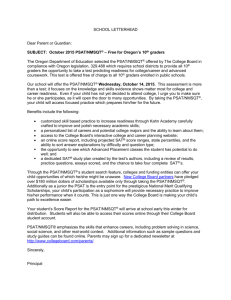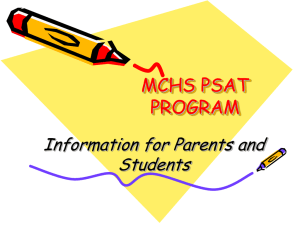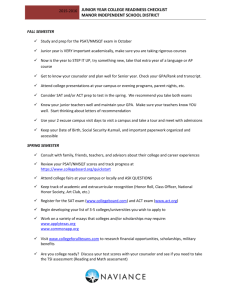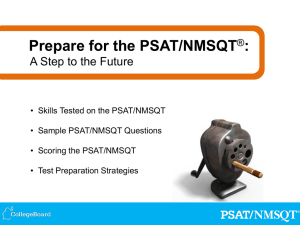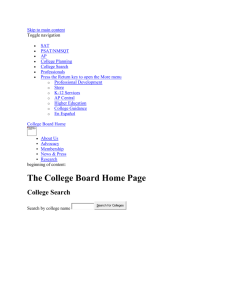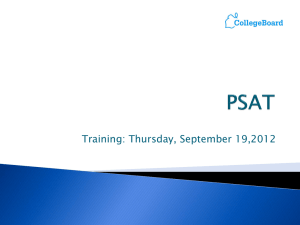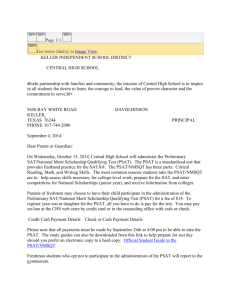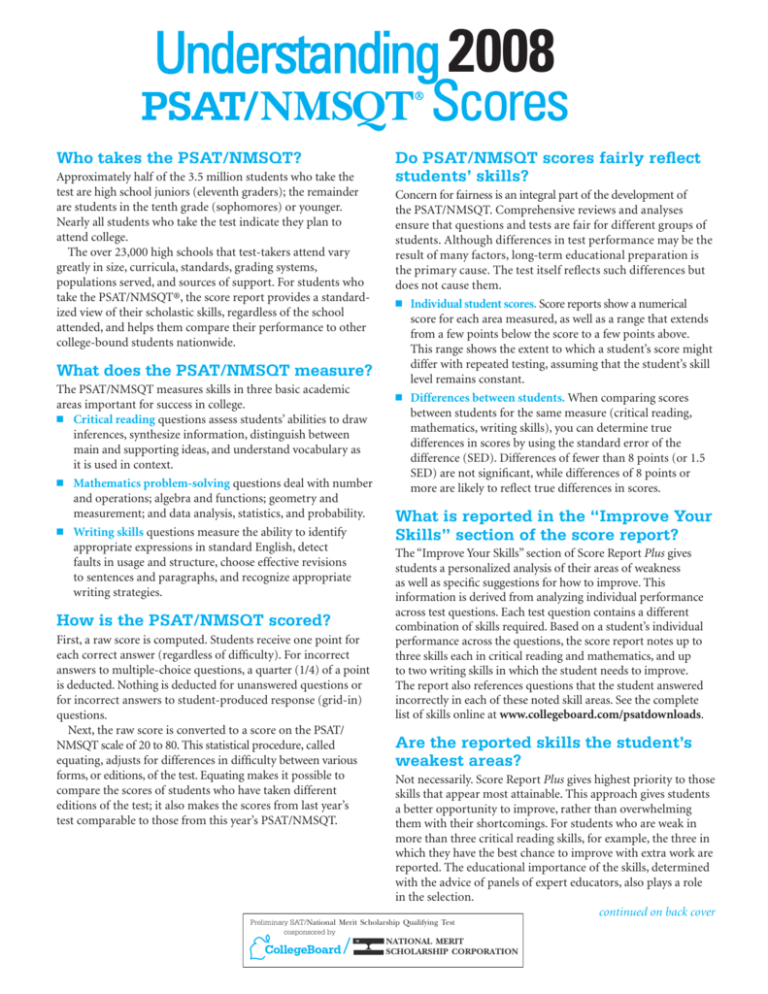
2008
Who takes the PSAT/NMSQT?
Approximately half of the 3.5 million students who take the
test are high school juniors (eleventh graders); the remainder
are students in the tenth grade (sophomores) or younger.
Nearly all students who take the test indicate they plan to
attend college.
The over 23,000 high schools that test-takers attend vary
greatly in size, curricula, standards, grading systems,
­populations served, and sources of support. For students who
take the PSAT/NMSQT®, the score report provides a standardized view of their scholastic skills, regardless of the school
attended, and helps them compare their performance to other
college-bound students nationwide.
What does the PSAT/NMSQT measure?
The PSAT/NMSQT measures skills in three basic academic
areas important for success in college.
Critical reading questions assess students’ abilities to draw
inferences, synthesize information, distinguish between
main and supporting ideas, and understand vocabulary as
it is used in context.
Mathematics problem-solving questions deal with number
and operations; algebra and functions; geometry and
measurement; and data analysis, statistics, and probability.
Writing skills questions measure the ability to identify
appropriate expressions in standard English, detect
faults in usage and structure, choose effective revisions
to sentences and paragraphs, and recognize appropriate
writing strategies.
How is the PSAT/NMSQT scored?
First, a raw score is computed. Students receive one point for
each correct answer (regardless of difficulty). For incorrect
answers to multiple-choice questions, a quarter (1/4) of a point
is deducted. Nothing is deducted for unanswered questions or
for incorrect answers to student-produced response (grid-in)
questions.
Next, the raw score is converted to a score on the PSAT/
NMSQT scale of 20 to 80. This statistical procedure, called
­equating, adjusts for differences in difficulty between various
forms, or editions, of the test. Equating makes it possible to
compare the scores of students who have taken different
­editions of the test; it also makes the scores from last year’s
test comparable to those from this year’s PSAT/NMSQT.
Do PSAT/NMSQT scores fairly reflect
students’ skills?
Concern for fairness is an integral part of the development of
the PSAT/NMSQT. Comprehensive reviews and analyses
ensure that questions and tests are fair for different groups of
students. Although differences in test performance may be the
result of many factors, long-term educational preparation is
the primary cause. The test itself reflects such differences but
does not cause them.
Individual student scores. Score reports show a numerical
score for each area measured, as well as a range that extends
from a few points below the score to a few points above.
This range shows the extent to which a student’s score might
differ with repeated testing, assuming that the student’s skill
level remains constant.
Differences between students. When comparing scores
between students for the same measure (critical reading,
mathematics, writing skills), you can determine true
differences in scores by using the standard error of the
difference (SED). Differences of fewer than 8 points (or 1.5
SED) are not significant, while differences of 8 points or
more are likely to reflect true differences in scores.
What is reported in the “Improve Your
Skills” section of the score report?
The “Improve Your Skills” section of Score Report Plus gives
students a personalized analysis of their areas of weakness
as well as specific suggestions for how to improve. This
information is derived from analyzing individual performance
across test questions. Each test question contains a different
combination of skills required. Based on a student’s individual
performance across the questions, the score report notes up to
three skills each in critical reading and mathematics, and up
to two writing skills in which the student needs to improve.
The report also references questions that the student answered
incorrectly in each of these noted skill areas. See the complete
list of skills online at www.collegeboard.com/psatdownloads.
Are the reported skills the student’s
weakest areas?
Not necessarily. Score Report Plus gives highest priority to those
skills that appear most attainable. This approach gives students
a better opportunity to improve, rather than overwhelming
them with their shortcomings. For students who are weak in
more than three critical reading skills, for example, the three in
which they have the best chance to improve with extra work are
reported. The educational importance of the skills, determined
with the advice of panels of expert educators, also plays a role
in the selection.
continued on back cover
Preliminary SAT/National?Merit?Scholarship?Qualifying?Test
cosponsored by
/
NATIONAL?MERIT
SCHOLARSHIP?CORPORATION
PSAT/NMSQT Percentiles and Mean Scores
can be used to compare a student’s performance with that of juniors and sophomores.
JUNIORS
Percentiles
Percentiles
Score
Critical
Reading
Math
Writing
Skills
Score
Critical
Reading
Math
Writing
Skills
80
79
78
77
76
75
74
73
72
71
70
99+
99+
99+
99
99
99
99
99
98
98
97
99+
99+
99+
99
99
99
98
98
98
97
97
99+
99+
99+
99
99
99
99
98
98
98
98
80
79
78
77
76
75
74
73
72
71
70
99+
99+
99+
99+
99+
99+
99+
99+
99
99
99
99+
99+
99+
99+
99+
99+
99
99
99
99
99
99+
99+
99+
99+
99+
99+
99+
99+
99+
99+
99
69
68
67
66
65
64
63
62
61
60
97
96
96
95
93
92
91
90
88
86
96
94
92
92
90
88
87
85
83
80
97
96
96
96
94
93
92
90
90
88
69
68
67
66
65
64
63
62
61
60
99
99
98
98
97
97
96
96
95
94
98
98
97
97
96
95
94
93
92
90
99
99
99
99
98
97
97
96
96
95
59
58
57
56
55
54
53
52
51
50
85
82
80
78
76
74
71
68
62
59
79
76
73
71
70
66
63
59
56
52
85
85
83
81
79
75
72
68
66
63
59
58
57
56
55
54
53
52
51
50
93
91
90
89
87
85
83
81
77
74
89
87
85
83
83
80
77
74
71
68
93
93
92
91
89
87
84
82
80
78
49
48
47
46
45
44
43
42
41
40
55
52
49
45
41
37
35
32
28
25
49
45
42
41
38
34
31
26
25
22
59
55
54
50
48
44
40
36
33
31
49
48
47
46
45
44
43
42
41
40
71
69
65
62
58
54
52
48
44
40
65
61
58
58
54
50
47
40
39
36
74
71
70
67
65
62
58
53
49
48
39
38
37
36
35
34
33
32
31
30
24
20
18
17
15
13
10
10
9
7
19
16
14
11
11
9
7
7
5
5
28
24
21
17
16
13
11
10
8
6
39
38
37
36
35
34
33
32
31
30
40
34
31
31
27
23
20
20
18
15
31
27
23
20
20
17
13
13
9
9
44
39
35
30
28
24
20
19
15
11
29
28
27
26
25
24
23
22
21
20
6
6
4
4
4
3
3
2
2
1
3
3
3
2
2
1
1
1
1
1
5
5
3
3
3
2
2
2
1
1
29
28
27
26
25
24
23
22
21
20
12
12
9
9
9
6
6
5
5
1
6
6
6
4
4
3
3
3
3
1
11
9
6
6
6
4
4
4
2
1
Mean score
46.8
48.9
45.9
Mean score
41.9
44.3
41.3
11.3
Standard
deviation
11.4
11.1
10.6
1,002,119
Number of
sophomores
in sample
1,009,739
1,009,739
1,009,739
Standard
deviation
Number of
juniors
in sample
Points to Note
SOPHOMORES
11.6
1,002,119
11.6
1,002,119
Percentiles indicate the percentage of
students whose scores fall below each
specified score.
On the score report, percentiles
for juniors compare their performance with that of other juniors
who took the test. For sophomores
or younger students, percentiles
compare their performance with that
of sophomores.
Percentiles are based on the critical
reading, mathematics, and writing
skills scores earned by a sample of
college-bound juniors or sophomores who took the PSAT/NMSQT
in 2008.
The mean score is the statistic that
describes the average performance of
a group.
The standard deviation is a measure
of the variability of a set of scores
around their mean. If the test scores
cluster tightly around the mean
score, as they do when the group
tested is relatively homogeneous, the
standard deviation is smaller than it
would be for a more diverse group.
Reliability
shows how consistently a student would
earn similar scores in repeated testings.
Reliability
Coefficient
Average
SEM
0.88
0.89
0.87
3.8
3.7
3.9
Critical Reading
Mathematics
Writing Skills
Points to Note
Data are based on a sample of sophomores and
juniors who took the PSAT/NMSQT in the previous
year (2007 Wednesday and Saturday forms).
A reliability coefficient helps to show expected
fluctuation in scores if a student takes a test
more than once. The higher the reliability
coefficient, the smaller the fluctuation of scores
across repeated testings. A reliability coefficient
of 1.00 would indicate perfect reliability, or no
expected fluctuation.
PSAT/NMSQT scores should be interpreted as
ranges rather than points. The standard error of
measurement (SEM) in the table above indicates
that a student who took different forms of the
test under identical conditions would be likely
to earn scores within 4 points of one another.
Selection Index Percentiles and Mean Score
can be used to compare a student’s performance with that of juniors.
Points to Note
JUNIORS
Selection
Index
Percentile
Selection
Index
240-223
222
221
Selection Index
Percentile
Percentile
99+
99
99
163
162
161
74
73
72
103
102
101
12
11
10
220
219
218
217
216
215
214
213
212
211
99
99
99
99
99
99
99
99
99
98
160
159
158
157
156
155
154
153
152
151
71
70
69
68
67
66
65
64
62
61
100
99
98
97
96
95
94
93
92
91
10
9
9
8
8
7
7
6
6
6
210
209
208
207
206
205
204
203
202
201
98
98
98
98
98
97
97
97
97
96
150
149
148
147
146
145
144
143
142
141
60
59
58
56
55
54
53
52
50
49
90
89
88
87
86
85
84
83
82
81
5
5
5
4
4
4
3
3
3
2
200
199
198
197
196
195
194
193
192
191
96
96
96
95
95
95
94
94
94
93
140
139
138
137
136
135
134
133
132
131
48
47
45
44
43
42
41
39
38
37
80
79
78
77
& below
2
2
2
1
190
189
188
187
186
185
184
183
182
181
93
92
92
91
91
90
90
89
89
88
130
129
128
127
126
125
124
123
122
121
36
35
34
32
31
30
29
28
27
26
180
179
178
177
176
175
174
173
172
171
88
87
86
86
85
84
84
83
82
81
120
119
118
117
116
115
114
113
112
111
25
24
23
22
21
20
20
19
18
17
170
169
168
167
166
165
164
81
80
79
78
77
76
75
110
109
108
107
106
105
104
16
16
15
14
13
13
12
Mean score
Reported on a scale ranging from 60 to 240, the
Selection Index is the sum of the critical reading,
mathematics, and writing skills scores. For example,
a critical reading score of 56, a mathematics score of
62, and a writing skills score of 59 would result in
a Selection Index of 177 (56 + 62 + 59).
Percentiles are based on the Selection Index earned
by a sample of college-bound juniors who took the
PSAT/NMSQT in 2008.
How NMSC Uses the
Selection Index
141.6
Standard deviation
31.8
Number of juniors in sample
1,002,119
National Merit Scholarship Corporation (NMSC)
uses the Selection Index score to designate groups of
students to receive recognition in the programs it conducts. Entry to NMSC’s competitions for scholarships to
be offered in 2010 is determined by students’ responses
to program entry questions on the 2008 PSAT/NMSQT
answer sheet. Both the PSAT/NMSQT Score Report
Plus and the Roster of Student Scores and Plans show
the student’s Selection Index, the student’s responses
to four entry items, and whether the student meets
participation requirements. Currently, more than 1.5
million test-takers meet requirements to enter NMSC’s
competitions each year.
Of the more than 1.5 million NMSC program
entrants, about 55,000 will earn 2008 PSAT/NMSQT
scores high enough to qualify them for recognition. These
students will be notified of their standing through their
high schools in September 2009. Students who qualify
to continue in the competitions for scholarships to be
offered in 2010 must then meet academic and other
requirements specified by NMSC to be considered
for awards.
Detailed descriptions of NMSC programs are
published in the Guide to the National Merit®
Scholarship Program and the National Achievement®
Scholarship Program Information Booklet, mailed to high
school principals each fall. For students and parents,
information about the competitions is given in the
Official Student Guide to the PSAT/NMSQT and at
www.nationalmerit.org.
Inquiries about any aspect of the National Merit
Program or National Achievement Program—
including entry requirements, the selection process, and
awards to be offered—should be sent to National
Merit Scholarship Corporation, 1560 Sherman
Avenue, Suite 200, Evanston, IL 60201-4897;
telephone 847 866-5100.
2008 PSAT/NMSQT Answer Keys
show the correct answers for Form W and Form S of the 2008 test.
FORM W
CRITICAL
READING
MATH
WRITING
SKILLS
CRITICAL
READING
MATH
WRITING
SKILLS
Section 1
Section 2
Section 5
Section 1
Section 2
Section 5
1.
2.
3.
4.
5.
6.
7.
8.
9.
10.
11.
12.
13.
14.
15.
16.
17.
18.
19.
20.
21.
22.
23.
24.
D
B
A
D
C
E
C
D
A
C
E
C
D
E
D
C
D
D
D
B
D
C
D
B
Section 3
25.
26.
27.
28.
29.
30.
31.
32.
33.
34.
35.
36.
37.
38.
39.
40.
41.
42.
43.
44.
45.
46.
47.
48.
FORM S
A
D
E
C
D
D
B
C
D
E
A
A
C
E
E
B
D
D
E
D
D
E
E
E
1.
2.
3.
4.
5.
6.
7.
8.
9.
10.
11.
12.
13.
14.
15.
16.
17.
18.
19.
20.
D
A
C
A
E
C
A
A
B
C
D
C
B
E
D
B
B
B
E
A
Section 4
21.
22.
23.
24.
25.
26.
27.
28.
29.
30.
31.
32.
33.
34.
35.
36.
37.
38.
C
A
D
E
B
C
E
C
44
3
2017
99/2 or 49.5
3/2 or 1.5
3, 8, or 23
200
1998
112
75/2 < x < 38/1
1.
2.
3.
4.
5.
6.
7.
8.
9.
10.
11.
12.
13.
14.
15.
16.
17.
18.
19.
20.
21.
22.
23.
24.
25.
26.
D
C
C
B
A
C
C
D
C
C
C
D
C
A
D
E
E
B
C
A
A
B
A
C
E
D
27.
28.
29.
30.
31.
32.
33.
34.
35.
36.
37.
38.
39.
A
A
E
A
C
C
B
A
D
C
B
A
B
1.
2.
3.
4.
5.
6.
7.
8.
9.
10.
11.
12.
13.
14.
15.
16.
17.
18.
19.
20.
21.
22.
23.
24.
A
D
D
B
C
E
E
B
D
C
B
B
E
B
D
D
C
E
E
B
A
D
A
D
Section 3
25.
26.
27.
28.
29.
30.
31.
32.
33.
34.
35.
36.
37.
38.
39.
40.
41.
42.
43.
44.
45.
46.
47.
48.
A
B
B
D
B
A
C
E
B
C
C
E
E
A
B
C
E
C
B
B
B
E
A
D
1.
2.
3.
4.
5.
6.
7.
8.
9.
10.
11.
12.
13.
14.
15.
16.
17.
18.
19.
20.
D
B
A
D
E
C
C
A
B
C
B
A
C
D
E
B
B
E
C
D
Section 4
21.
22.
23.
24.
25.
26.
27.
28.
29.
30.
31.
32.
33.
34.
35.
36.
37.
38.
C
D
A
E
E
A
E
B
9/2 or 4.5
1250
115
9
6
12
2/5 or .4
0<x<1
1983
2/15 or .133
1.
2.
3.
4.
5.
6.
7.
8.
9.
10.
11.
12.
13.
14.
15.
16.
17.
18.
19.
20.
21.
22.
23.
24.
25.
26.
D
D
B
E
C
D
C
B
D
C
A
C
A
B
E
E
E
B
D
C
D
E
D
A
B
B
27.
28.
29.
30.
31.
32.
33.
34.
35.
36.
37.
38.
39.
B
E
A
C
E
B
D
C
D
C
D
B
D
2008 PSAT/NMSQT Score Conversion Tables
show how points obtained on the test are converted to scores on the 20–80 PSAT/NMSQT scale.
PSAT/NMSQT
FORM W — Wednesday, October 15, 2008
Scores
Points
Critical
Reading
48
47
46
45
44
43
42
41
40
39
38
37
36
35
34
33
32
31
30
29
28
27
26
25
24
23
22
21
20
19
18
17
16
80
80
77
75
74
72
70
68
67
66
65
64
63
62
61
60
59
58
57
56
55
54
53
52
51
51
50
49
48
47
46
45
44
Math
80
77
74
71
69
68
67
65
64
62
61
60
58
57
56
54
53
52
51
50
49
48
47
Writing Skills
Points
80
77
73
72
70
68
65
64
63
62
60
59
57
56
55
54
53
52
51
50
49
48
46
45
PSAT/NMSQT
FORM S — Saturday, October 18, 2008
Scores
Critical Reading Math
15
14
13
12
11
10
9
8
7
6
5
4
3
2
1
0
-1
-2
-3
-4
-5
-6
-7
-8
-9
-10
-11
-12
43
42
41
40
38
38
37
35
34
33
31
30
29
27
24
22
20
20
20
20
20
20
20
20
20
20
20
20
45
44
43
42
42
40
39
38
37
36
34
33
31
29
26
24
20
20
20
20
20
20
20
Writing
Skills
44
43
42
41
40
39
38
37
36
35
34
33
31
30
28
27
24
21
20
20
20
20
20
20
20
20
Scores
Points
Critical
Reading
48
47
46
45
44
43
42
41
40
39
38
37
36
35
34
33
32
31
30
29
28
27
26
25
24
23
22
21
20
19
18
17
16
80
80
78
77
75
74
71
70
69
68
66
65
64
63
62
61
60
58
57
57
56
54
53
52
52
51
50
49
48
47
46
45
44
Writing Skills
Points
Math
80
75
72
70
68
67
66
64
63
62
60
59
58
57
55
54
53
52
51
50
49
48
46
80
76
73
71
69
67
65
63
62
61
59
58
56
55
54
53
52
51
50
49
48
47
46
45
15
14
13
12
11
10
9
8
7
6
5
4
3
2
1
0
-1
-2
-3
-4
-5
-6
-7
-8
-9
-10
-11
-12
Scores
Critical Reading Math
43
42
41
45
44
43
42
41
40
39
38
37
36
35
33
32
30
28
26
24
21
20
20
20
20
20
40
39
38
37
36
34
33
32
31
29
27
24
23
20
20
20
20
20
20
20
20
20
20
20
20
Writing
Skills
44
43
42
40
39
38
37
36
35
34
32
31
29
27
26
24
22
20
20
20
20
20
20
20
20
20
Important to Note
Points represent the total number of
correct answers minus a quarter (1/4)
of a point for each incorrect answer
to a multiple-choice question.
Nothing is deducted for incorrect
answers to student-produced
response questions or for omitted
answers of any type.
Points are totaled, then converted
to scores on the 20–80 PSAT/NMSQT
scale.
Converting points to scores adjusts
for slight differences in difficulty
between various forms. A statistical
process called equating adjusts
for these small differences. This
ensures that a score of, say, 65 on
one form of the test reflects a similar
level of performance as does a 65
on another form of the test.
There is no advantage or disadvantage
in taking either the Wednesday or the
Saturday test form.
2008 PSAT/NMSQT Answer Key/Score Conversion Table
shows the correct answers for the alternate form of the 2008 test and how points obtained on the test are
converted to scores on the 20–80 PSAT/NMSQT scale.
ANSWER KEY
SCORE CONVERSION TABLE
FORM A — Alternate Form 2008
FORM A — Alternate Form 2008
CRITICAL
READING
MATH
WRITING
SKILLS
Section 1
Section 2
Section 5
1.
2.
3.
4.
5.
6.
7.
8.
9.
10.
11.
12.
13.
14.
15.
16.
17.
18.
19.
20.
21.
22.
23.
24.
E
B
E
B
D
C
B
E
C
D
E
D
D
B
D
E
E
A
C
A
E
E
C
C
Section 3
25.
26.
27.
28.
29.
30.
31.
32.
33.
34.
35.
36.
37.
38.
39.
40.
41.
42.
43.
44.
45.
46.
47.
48.
A
D
E
E
E
C
E
B
D
C
B
B
B
C
A
C
B
A
E
D
B
B
E
D
1.
2.
3.
4.
5.
6.
7.
8.
9.
10.
11.
12.
13.
14.
15.
16.
17.
18.
19.
20.
C
B
B
E
C
A
E
D
E
A
C
A
D
D
C
D
C
B
A
D
Section 4
21.
22.
23.
24.
25.
26.
27.
28.
29.
30.
31.
32.
33.
34.
35.
36.
37.
38.
A
B
A
D
C
E
C
C
17
9/2 or 4.5
124
10
18 or 19
1430
1/5 or .2
237
8
480
Scores
Critical
Points Reading Math
Scores
Writing Critical
Writing
Skills
Points Reading Math
Skills
1.
2.
3.
4.
5.
6.
7.
8.
9.
10.
11.
12.
13.
14.
15.
16.
17.
18.
19.
20.
21.
22.
23.
24.
25.
26.
B
A
E
A
D
A
E
D
C
D
D
E
E
B
A
C
C
E
E
D
B
D
E
B
C
D
48
80
15
43
45
43
47
80
14
42
44
42
46
78
13
41
43
41
45
76
12
40
42
40
44
73
11
39
41
39
43
72
10
38
40
38
42
70
9
37
39
38
41
69
8
36
38
37
40
67
7
35
37
35
39
66
80
6
34
36
34
38
65
80
78
5
33
34
33
37
64
76
74
4
32
33
32
36
63
72
71
3
31
32
31
35
62
70
68
2
29
30
29
34
61
68
66
1
28
28
27
33
60
67
64
0
26
26
24
32
59
65
62
-1
24
24
20
31
58
64
61
-2
21
22
20
30
57
62
59
-3
20
20
20
29
56
61
58
-4
20
20
20
28
55
60
57
-5
20
20
27
54
58
56
-6
20
20
20
20
27.
28.
29.
30.
31.
32.
33.
34.
35.
36.
37.
38.
39.
C
B
B
B
C
D
C
E
B
C
C
C
C
26
53
57
54
-7
20
20
20
25
52
56
53
-8
20
20
24
51
55
52
-9
20
20
23
50
54
51
-10
20
20
22
49
52
50
-11
20
21
48
51
49
-12
20
20
47
50
48
19
46
49
47
18
45
48
46
17
44
47
45
16
44
46
44
Score Change From PSAT/NMSQT to SAT®
shows how scores change for students who take the PSAT/NMSQT in October
and the SAT the following spring.
Points to Note
The PSAT/NMSQT reports
scores on a scale from 20 to 80.
Scores on the SAT® are reported
on a 200-to-800 scale.
The left-hand column of this
table groups juniors by score
ranges on the PSAT/NMSQT.
Columns to the right show the
percentage of students who
gained or lost points when they
took the SAT the following
spring. The far right column
shows the average SAT score
for the group of juniors in each
score range.
On average, juniors taking the
PSAT/NMSQT in October and
the SAT the following spring
have SAT scores that are 17
points higher in critical reading,
16 points higher in math, and 22
points higher in writing
(equivalent to 1.7, 1.6, and 2.2
points, respectively, on the
PSAT/NMSQT scale).
Of the PSAT/NMSQT testtakers who took the SAT in the
spring, 60% had SAT critical
reading scores that were higher,
7% had scores that stayed the
same, and 33% had lower
scores; 58% had SAT math
scores that were higher, 8% had
scores that stayed the same, and
34% had lower scores; 62% had
SAT writing scores that were
higher, 6% had scores that
stayed the same, and 32% had
scores that were lower than their
corresponding PSAT/NMSQT
scores.
Relatively low PSAT/NMSQT
scores are followed by larger
average gains than are relatively
high PSAT/NMSQT scores.
Several factors can influence the
amount that scores will change,
such as a student’s academic
course work and outside
reading.
Percentage of Junior-Year Students with a Score Gain or Loss Between the PSAT/NMSQT and the SAT
CRITICAL READING
Junior-Year
PSAT/
NMSQT
Scores
Average of
Junior-Year
SAT Scores
-140 &
below
-110
to
-130
-80
to
-100
-50
to
-70
-20
to
-40
-10
to
+10
+20
to
+40
+50
to
+70
+80
to
+100
+110
to
+130
68-72
1
1
4
11
22
24
22
10
5
1
63-67
1
1
3
9
19
27
20
13
5
1
1
652
58-62
1
1
3
8
17
24
23
15
6
2
1
609
53-57
1
1
2
7
15
23
24
16
8
2
1
563
48-52
1
3
7
15
22
24
17
8
3
1
515
43-47
1
2
7
14
22
23
17
9
3
1
469
38-42
1
2
5
11
20
23
20
11
5
2
429
1
2
4
9
16
22
21
13
7
3
386
1
3
3
7
12
17
22
18
10
7
352
-80
to
-100
-50
to
-70
-20
to
-40
-10
to
+10
+20
to
+40
+50
to
+70
+80
to
+100
+110
to
+130
33-37
1
28-32
+140 &
above
694
MATHEMATICS
Junior-Year
PSAT/
NMSQT
Scores
-140 &
below
-110
to
-130
68-72
1
1
4
11
22
24
19
11
6
1
63-67
1
1
4
8
17
27
22
12
5
2
1
656
58-62
1
1
3
9
16
23
23
16
6
2
1
611
53-57
1
1
3
8
15
21
22
16
9
3
1
566
48-52
1
3
7
15
23
22
16
9
4
1
522
43-47
1
2
6
13
21
24
18
9
4
2
475
38-42
1
2
5
13
21
25
18
10
4
2
426
33-37
1
2
6
11
16
23
20
13
5
3
380
28-32
1
4
5
9
16
18
20
15
8
4
341
-80
to
-100
-50
to
-70
-20
to
-40
-10
to
+10
+20
to
+40
+50
to
+70
+80
to
+100
+110
to
+130
+140 &
above
Average of
Junior-Year
SAT Scores
700
WRITING
Junior-Year
PSAT/
NMSQT
Scores
-140 &
below
-110
to
-130
68-72
2
4
9
15
19
20
15
9
5
2
63-67
1
2
7
13
19
20
18
11
5
3
1
643
58-62
1
1
4
9
16
21
20
14
8
3
2
607
53-57
1
1
3
8
15
20
21
16
9
5
2
569
48-52
1
3
7
13
19
21
17
11
5
3
525
43-47
1
2
6
12
19
21
18
12
6
3
482
38-42
1
2
5
11
18
21
19
13
7
4
435
33-37
1
2
4
9
16
21
20
14
8
6
393
2
3
7
12
19
20
17
10
9
360
28-32
+140 &
above
Average of
Junior-Year
SAT Scores
680
Data are based on 585,947 students who took the PSAT/NMSQT as juniors in October 2007
and the SAT as juniors in spring 2008. The first SAT score from either the March, May, or
June 2008 administration was used.
Can PSAT/NMSQT scores be used to
estimate SAT scores?
PSAT/NMSQT critical reading, mathematics, and writing skills
questions are designed to be the same as those on the SAT. This
is deliberate, as the PSAT/NMSQT questions are intended to be
reliable preparation for the same types of questions on the SAT.
The PSAT/NMSQT scale of 20 to 80 is comparable to the SAT
scale of 200 to 800.
Estimated SAT score ranges are included on high school
students’ supplemental, online score reports in My College
QuickStart™. Two times out of three, students earn SAT scores
within these ranges, but actual scores may be higher (or lower)
than these estimates. (As SAT writing scores also include an essay,
there will be more variability in the estimates of those scores.)
Higher-than-estimated SAT scores may result from intervening
activities, such as:
developing skills through rigorous academic courses;
participating in problem-solving activities;
extensive, quality outside reading and/or writing;
following the personalized advice in My SAT Study Plan™
in My College QuickStart; and
becoming more familiar with test directions, types of
questions, and pacing.
Juniors frequently take the SAT six or seven months after
taking the PSAT/NMSQT. Estimated SAT scores assume the SAT
is taken within a year of the PSAT/NMSQT. Sophomores might
not take the SAT for 18 months, providing a greater opportunity
for intervening activities to influence their SAT scores.
What PSAT/NMSQT reports do schools
receive?
The following standard reports are provided to all schools:
PSAT/NMSQT Score Report Plus for each student tested (one
for the student and one for the school)
Score Labels, summarizing the basic score information (one set
of labels)
Roster of Student Scores and Plans, listing student-reported
information, scores, and My College QuickStart access code
for each student, as well as educator access codes for online
tools and reports.
School Summary Report (provided automatically if at least
50 of a school’s eleventh graders or tenth graders tested at the
school), summarizing score statistics and student-reported
information. Schools that test fewer than 50 eleventh graders/
tenth graders, but at least 25 of their own students of the same
sex and grade level, receive Summary Statistics.
The following tools and reports are available online at
www.collegeboard.com/reports.
AP Potential™, a Web-based tool identifying more students
with the potential for success in Advanced Placement
Program® (AP®) courses.
Summary of Answers and Skills, aggregating student
responses to each test question and providing information on
skills that need improvement.
PSAT/NMSQT Summary Reports: National, Regional, and
State Data, providing score statistics and student-reported
information for juniors and sophomores, including final
mean scores. Reports for 2008 will be available in the spring
of 2009.
The following optional reports are available for a small fee. To
order, visit www.collegeboard.com/school.
School Summary Report, summarizing score data for
schools that test fewer than 50 juniors/50 sophomores, or
for schools that have some juniors or sophomores who
tested elsewhere. Schools that test 50 or more of their
juniors/sophomores automatically receive this report.
Student Data File, including all student-provided data as
well as scores, skills, and students’ My College QuickStart
access codes. (Available in either Excel-ready or ASCII
format.)
My College QuickStart
www.collegeboard.com/quickstart
My College QuickStart is an easy-to-use, online, personalized
college and career planning kit for all students who take
the PSAT/NMSQT. This useful tool incorporates responses
students provided when they took the test and presents
personalized information in four main parts: My Online Score
Report, My SAT Study Plan, My College Matches, and My
Major & Career Matches. My College QuickStart is available
using the access code printed on the student’s score report,
and it can be utilized throughout high school.
How should schools use PSAT/
NMSQT score reports?
The PSAT/NMSQT is intended to help students evaluate skill
levels in three critical academic areas; prepare for the SAT;
compare their readiness for college-level work with that of their
peers; and enter scholarship competitions. Score reports should
be used for counseling students about educational plans.
PSAT/NMSQT scores are not for use by colleges as part of
their admission criteria. Do not include scores on student
transcripts that will be reproduced and sent to colleges unless
the student (age 18 or older) or parent/guardian has granted
permission. Inform students of their right to withhold these
scores from admission or athletic offices, even when requested.
Questions?
Visit www.collegeboard.com/counselors/psat for additional
data relevant to the test. Or contact the PSAT/NMSQT
program at:
Mail: P.O. Box 6720, Princeton, NJ 08541-6720
Phone: 888 477-PSAT (7728) (for educators only)
609 771-7070
8 a.m. to 4 p.m. eastern time
Fax:
610 290-8979
E-mail: psat@info.collegeboard.org
Plan Ahead for
2009 PSAT/NMSQT Dates
Wednesday, October 14, 2009 • Saturday, October 17, 2009
© 2008 The College Board. All rights reserved. College Board, AP, Advanced Placement Program, SAT, and the acorn logo are registered trademarks of the College Board. AP
Potential, My College QuickStart, and My SAT Study Plan are trademarks owned by the College Board. PSAT/NMSQT is a registered trademark of the College Board and
National Merit Scholarship Corporation. Permission is hereby granted to any nonprofit school to reproduce this publication in whole or in part in limited quantities for
distribution to students, parents, and staff, but not for sale, provided that the copyright notice appears on all reproduced materials.
75464-02079 • WEBPDF118
745806

